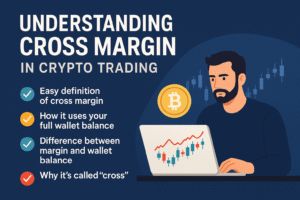Global markets have entered a new wave of uncertainty as tensions rise once again between the United States and China.
Trade restrictions, tariff threats, and geopolitical rivalry are shaking investor confidence, pushing money toward safe and alternative assets. This renewed conflict isn’t just about politics — it’s about economic power, supply chain dominance, and market stability.
Why Global Markets Are Reacting to Renewed US–China Tensions
Every time the world’s two largest economies clash, global markets feel the impact. Stock markets often dip due to fears of slower trade and disrupted supply chains. Companies that depend on Chinese manufacturing or U.S. technology exports face higher costs and reduced profits. Investors quickly move away from risky assets like equities toward safer options, triggering volatility in global indices, commodities, and currencies.
How Bitcoin and Gold Connect to This Global Story
Bitcoin and Gold both act as “safe haven” assets when traditional markets face uncertainty.
-
Gold rises because investors see it as a timeless store of value that holds strong during inflation or crisis.
-
Bitcoin, the “digital gold,” attracts those seeking decentralized assets not tied to any government.
When U.S.–China tensions escalate, both assets often gain momentum — reflecting a shift in investor trust from fiat currencies and stock markets toward alternative stores of value.
Background: US–China Trade Tensions
What Triggered the Latest Round of Trade Conflict in 2025
In 2025, the long-standing rivalry between the United States and China reignited after new U.S. export restrictions targeted China’s high-tech industries, especially semiconductors and artificial intelligence equipment. The move was seen as an attempt to slow China’s technological rise. In response, China imposed new export controls on rare earth materials — key elements used in electronics, defense, and electric vehicles.
This tit-for-tat escalation quickly turned into a full-blown trade conflict, with both nations imposing new tariffs and threatening further economic retaliation. The situation reminded global investors of the 2018–2020 trade war but with even higher stakes due to advanced technology and national security concerns.
Key Updates and Events: Tariffs, Tech Bans, and Export Limits
The trade battle in 2025 has three major fronts — tariffs, technology restrictions, and export limits.
-
Tariffs: The U.S. announced plans to raise tariffs on Chinese imports to record levels, while China responded by increasing duties on American goods, especially agricultural and energy products.
-
Tech Bans: The U.S. expanded restrictions on Chinese technology firms, limiting access to advanced chips and software. Major American companies were also barred from exporting AI-related tools to China.
-
Export Limits: China struck back by tightening control over rare earth exports, essential for global electronics and clean energy industries. These materials became a powerful bargaining tool in Beijing’s hands.
Together, these measures disrupted global supply chains and sparked fears of another economic slowdown.
Current Situation Between Washington and Beijing
As of now, both Washington and Beijing are maintaining a tough stance but leaving limited room for negotiation. U.S. officials insist that the restrictions are necessary to protect national security, while China accuses the U.S. of trying to suppress its growth and global influence.
Talks between the two sides continue intermittently, but trust remains low. Global markets are on edge as businesses worry about rising costs, production delays, and declining trade stability. While some short-term easing has occurred after high-level discussions, the core issues — technology dominance, supply chain control, and political rivalry — remain unresolved.
Gold: The Traditional Safe Haven
Why Investors Move Toward Gold During Uncertainty
Gold has always been the world’s most trusted safe-haven asset. When markets fall or political tensions rise, investors turn to gold because it maintains its value even when currencies weaken. During crises like the renewed U.S.–China trade war, inflation concerns, or central bank rate cuts, gold becomes a preferred store of wealth.
It’s not just individual investors — central banks and large funds also increase their gold holdings to protect reserves against currency risk and stock market volatility. In simple terms, when fear grows in the market, demand for gold usually rises.
How Easing Tensions Are Changing Gold Demand
When tensions between major economies start to cool, investors gradually move back to riskier assets like stocks and bonds. As a result, gold demand often slows down in the short term. However, in 2025, even with temporary easing between Washington and Beijing, investors remain cautious due to ongoing global inflation, currency fluctuations, and geopolitical instability.
This means that while gold prices may face brief corrections, long-term demand remains strong — especially from emerging markets and central banks diversifying away from the U.S. dollar.
Latest Gold Price Trends and Future Outlook
Gold prices have stayed relatively high in 2025, supported by global uncertainty, moderate inflation, and growing central bank purchases. The precious metal has become a strategic asset rather than just a short-term hedge.
Looking ahead, analysts expect gold to remain strong if U.S.–China tensions continue or if central banks worldwide maintain lower interest rates. However, if trade relations improve and economic growth stabilizes, gold may experience mild profit-taking before finding support again.
In short — gold remains the “crisis metal,” and even in periods of calm, it continues to play a key role in protecting portfolios from sudden market shocks.
Bitcoin: The Digital Hedge
Bitcoin’s Role During Global Political or Economic Pressure
Bitcoin has evolved into a modern alternative to traditional safe-haven assets. When global tensions rise — such as renewed U.S.–China trade conflicts or uncertain monetary policies — many investors view Bitcoin as a decentralized hedge against government-driven risks.
Unlike gold or fiat currencies, Bitcoin isn’t controlled by any country or central bank, which makes it appealing when political disputes or sanctions disrupt global trade. During moments of financial stress, capital often flows into Bitcoin as investors seek independence from traditional systems.
How Market Sentiment and Trade News Affect Bitcoin
Bitcoin’s price reacts quickly to global headlines. When news points to economic instability, trade disruptions, or currency depreciation, demand for Bitcoin tends to rise as traders look for protection and quick profits. On the other hand, if tensions ease or risk appetite increases, investors may shift back to equities or commodities, causing temporary corrections in crypto prices.
In 2025, every major policy move — from U.S. tariffs on China to interest rate decisions by the Federal Reserve — has triggered strong volatility in Bitcoin markets. This shows how closely digital assets are now tied to the global financial narrative.
Bitcoin vs. Gold Performance in 2025
In 2025, both Bitcoin and Gold have acted as safe havens — but in different ways.
-
Gold remained stable, supported by central banks and long-term investors.
-
Bitcoin showed higher volatility but delivered stronger short-term gains whenever global uncertainty spiked.
While Gold is trusted for stability, Bitcoin offers faster reactions to market shifts and higher potential returns — though with greater risk. Many investors now balance both: Gold for long-term security and Bitcoin for digital flexibility and growth potential.
Global Market Impact
How Trade Tensions Shift Investor Mood and Risk Appetite
Trade tensions between the U.S. and China have a direct impact on global investor sentiment. When tariff threats or export restrictions are announced, investors become cautious, often selling riskier assets like stocks and shifting toward safer options such as gold, bonds, or stable currencies.
This change in mood can trigger short-term volatility, weaken equity markets, and reduce global trade confidence. In 2025, every policy statement or tariff update has caused sharp market swings, proving how sensitive global investors are to U.S.–China relations.
The Federal Reserve’s Role and Interest Rate Impact
The Federal Reserve plays a central role in shaping market reactions to geopolitical tension. When trade uncertainty threatens economic growth, the Fed often cuts interest rates or signals a more “dovish” approach to support the economy.
Lower interest rates make borrowing cheaper, but they also reduce returns on traditional savings, pushing investors toward gold, crypto, and high-growth stocks. In contrast, when the Fed raises rates to control inflation, the U.S. dollar strengthens — often putting pressure on emerging markets and risky assets like Bitcoin.
In 2025, the Fed’s cautious stance and hints of further rate cuts have added extra fuel to gold and Bitcoin rallies.
Money Flow Trends: From Safe Havens to Digital Assets
The modern market now shows a split investor behavior. Traditionally, money moved into gold, bonds, and the dollar during global stress. But in recent years, a growing share has shifted into Bitcoin and other digital assets.
This trend highlights changing market psychology — investors want assets that are both globally accessible and less dependent on government control. As trade tensions rise or central banks adjust policy, we’re seeing more capital flow from traditional safe havens toward digital ones, blending old and new forms of financial protection.
What It Means for Investors
If Trade Tensions Grow vs. If a Deal Happens — Possible Outcomes
If U.S.–China tensions intensify, investors can expect global markets to stay volatile. Stocks may fall, trade-dependent sectors could face profit pressure, and safe-haven assets like Gold and Bitcoin would likely rise. The U.S. dollar might strengthen temporarily, but inflation risks could also grow if supply chains remain disrupted.
If a trade deal or temporary truce is reached, global sentiment would improve. Equity markets could rebound, commodity demand may rise, and safe-haven assets might cool slightly as investors return to riskier options. However, given the fragile trust between both sides, any deal would likely bring only short-term calm rather than full stability.
How to Balance Gold and Bitcoin in a 2025 Portfolio
A smart 2025 portfolio blends both traditional and digital protection.
-
Gold: Acts as a stabilizer. It protects long-term wealth and reduces portfolio volatility when markets drop.
-
Bitcoin: Adds high-growth potential. It reacts faster to global news and benefits from investor demand for digital independence.
A balanced approach could include a small but strategic portion of Bitcoin (for growth and agility) alongside a larger, steady allocation in Gold (for safety and stability). This mix helps investors handle both inflation shocks and market turbulence.
Key Risks and Safe-Strategy Tips
-
Volatility: Bitcoin remains highly unpredictable; prices can swing fast on global headlines.
-
Policy Shifts: Sudden central bank decisions or government crackdowns can change market direction instantly.
-
Diversification: Don’t rely on one asset — spread investments across Gold, crypto, equities, and cash reserves.
-
Stay Updated: Global news drives both assets. Track trade negotiations, Fed announcements, and inflation reports.
-
Long-Term View: Focus on stability and gradual growth instead of chasing short-term gains.
In short, 2025 is a year of both risk and opportunity — those who stay diversified, alert, and disciplined will manage uncertainty better than those who react emotionally to every headline.
Regional Impact (Global Market)
How Local Markets Could Be Indirectly Affected
Global markets are deeply interconnected, so U.S.–China tensions ripple across every region. When tariffs rise or tech bans expand, supply chains slow down, manufacturing costs increase, and investor confidence weakens.
Regions that depend on exports — such as Europe, Southeast Asia, and Latin America — often see reduced trade volumes and slower growth. Emerging markets face additional pressure as global investors move funds toward safer assets like the U.S. dollar or gold.
Currency fluctuations also become more common, affecting import costs and inflation rates worldwide. In short, even countries not directly involved in the trade war feel its economic and financial impact through higher costs, weaker currencies, and unstable investment flows.
What Regional Investors Should Monitor
Investors across all regions should closely track a few critical indicators:
-
U.S. and China Trade Announcements: Sudden tariff or export policy changes can quickly shift global sentiment.
-
Commodity Prices: Oil, copper, and gold react first to trade disruptions, revealing market stress or recovery trends.
-
Interest Rate Policies: Central banks, especially the Federal Reserve, influence global liquidity and risk appetite.
-
Currency Strength: A rising dollar usually signals risk aversion, while a weaker dollar can boost emerging markets.
-
Tech Sector Performance: Since technology lies at the core of the U.S.–China conflict, monitoring global chip and AI stocks offers early warning of market direction.
By staying alert to these signals, regional investors can better position themselves — protecting capital during volatility and taking advantage of opportunities when global stability returns.
Conclusion
Main Takeaways for Gold and Bitcoin Holders
The renewed U.S.–China trade tensions in 2025 have reminded investors that uncertainty remains a constant part of global markets. For those holding Gold and Bitcoin, the message is clear — both assets continue to serve as protection against volatility, though in different ways.
Gold provides stability and long-term preservation, ideal for those seeking security during inflation and geopolitical risk. Bitcoin, on the other hand, offers speed and growth potential, reacting quickly to global headlines and investor sentiment. Balancing both allows investors to stay protected while still benefiting from digital market opportunities.
Final Thoughts on Global Trade, Inflation, and Safe-Haven Demand
As the world watches the shifting relationship between Washington and Beijing, the global economy stands at a delicate point. Trade disputes, inflation pressures, and evolving monetary policies are reshaping how capital moves across borders.
Even if short-term agreements bring calm, structural competition between the U.S. and China is likely to persist — keeping safe-haven demand strong. In this environment, investors who diversify smartly, stay informed, and maintain long-term discipline will be best positioned to navigate uncertainty.
In simple terms — Gold will remain the timeless hedge, Bitcoin will stay the digital frontier, and both will continue to reflect how the world responds to power shifts and economic pressure.
Top 5 FAQs — US–China Tensions, Bitcoin & Gold (2025)
1. Why do global markets react so strongly to US–China trade tensions?
Because both nations dominate world trade. Any tariff or tech ban between them creates supply chain disruptions, affects currencies, and increases investor uncertainty.
2. How do trade tensions affect Bitcoin prices?
When investors fear global instability, some shift to Bitcoin as a digital hedge, driving prices up. But short-term volatility can still cause sharp corrections.
3. Why does Gold remain a safe haven even with Bitcoin’s rise?
Gold has centuries of trust, physical backing, and low correlation with risky assets — making it stable during political or economic shocks.
4. What’s the biggest risk for investors in 2025?
Sudden tariff hikes, currency fluctuations, or unexpected Fed decisions could trigger global sell-offs and impact both digital and traditional assets.
5. Should investors prefer Gold or Bitcoin this year?
Balanced exposure works best — Gold for stability, Bitcoin for growth. Diversifying between both helps hedge against inflation and market uncertainty.







